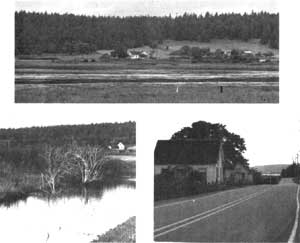|
EBEY'S LANDING
Ebey's Landing National Historical Reserve Reading the Cultural Landscape |

|
INTRODUCTION
The landscapes we see are the result of a long interaction between man and nature, a mixture of both natural systems and human features. Because both human values and nature change, landscapes also, by their nature, change over time. Some changes, such as the evolution of land forms, occur very slowly over many, many years. Other elements, such as the type of land use or the kind of crop grown may change seasonally within a single year.
When looking at landscapes we do not always see change as it happens, but over time, the impacts of change can imprint the land and in a sense, inscribe a human history in the physical landscape. Early patterns of settlement, types of land use, the development of roads and pathways, various kinds of structures and even front-lot gardens, are all pieces of a whole landscape and community history. If we can learn to see these individual pieces, and to understand them in relationship to each other over time, the landscape becomes a living history.
This report focuses on the visible resources of that living history as read in the landscape of Ebey's Landing National Historical Reserve. Although this study borrows from various other reports describing specific resources on the reserve, it emphasizes the total cultural landscape; how to read it, understand it, and protect its significant elements.
This report is divided into four parts. Part one discusses the primary settlement patterns and land uses on the reserve as they evolved over time. Part two reviews a few of the natural and cultural resources of the area that influenced and were impacted by these patterns. It is a guide to looking at both natural and human—built landscapes. Part three is an orientation and workbook section that illustrates techniques for reading the relationships among individual features, patterns or qualities that comprise the whole landscape. It brings the reader from individual feature to the total cultural landscape. Part four suggests preservation principles for protection of the reserve's historically significant landscape elements, both built and natural.

Within the landscape pictured above are both natural areas
like wetlands, and cultural elements, including houses and roads.
Landscape Development and Settlement Patterns | Looking at Landscapes | Reading the Landscape
Preservation Principles | Appendix | Bibliography
rcl/rcl2.htm
Last Updated: 07-Dec-2015